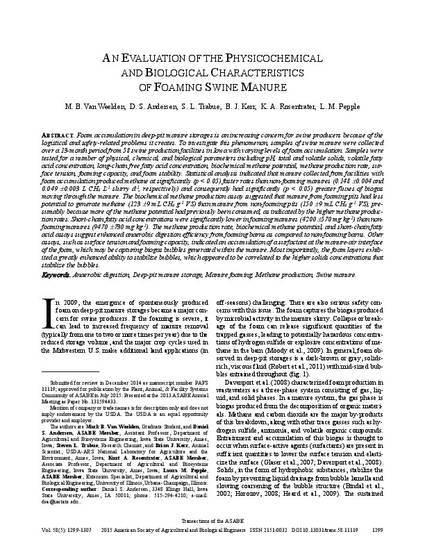
Foam accumulation in deep-pit manure storages is an increasing concern for swine producers because of the logistical and safety-related problems it creates. To investigate this phenomenon, samples of swine manure were collected over a 13-month period from 58 swine production facilities in Iowa with varying levels of foam accumulation. Samples were tested for a number of physical, chemical, and biological parameters including pH, total and volatile solids, volatile fatty acid concentration, long-chain free fatty acid concentration, biochemical methane potential, methane production rate, surface tension, foaming capacity, and foam stability. Statistical analysis indicated that manure collected from facilities with foam accumulation produced methane at significantly (p < 0.05) faster rates than non-foaming manures (0.148 ±0.004 and 0.049 ±0.003 L CH4 L-1 slurry d-1, respectively) and consequently had significantly (p < 0.05) greater fluxes of biogas moving through the manure. The biochemical methane production assay suggested that manure from foaming pits had less potential to generate methane (123 ±9 mL CH4 g-1 VS) than manure from non-foaming pits (150 ±9 mL CH4 g-1 VS), presumably because more of the methane potential had previously been consumed, as indicated by the higher methane production rates. Short-chain fatty acid concentrations were significantly lower in foaming manures (4200 ±570 mg kg-1) than non-foaming manures (9470 ±730 mg kg-1). The methane production rate, biochemical methane potential, and short-chain fatty acid assays suggest enhanced anaerobic digestion efficiency from foaming barns as compared to non-foaming barns. Other assays, such as surface tension and foaming capacity, indicated an accumulation of a surfactant at the manure-air interface of the foam, which may be capturing biogas bubbles generated within the manure. Most importantly, the foam layers exhibited a greatly enhanced ability to stabilize bubbles, which appeared to be correlated to the higher solids concentrations that stabilize the bubbles.
Available at: http://works.bepress.com/kurt_rosentrater/272/

This article was published in Transactions of the ASABE 58(5): 1299-1307 (doi: 10.13031/trans.58.11119). Copyright 2015 American Society of Agricultural and Biological Engineers.